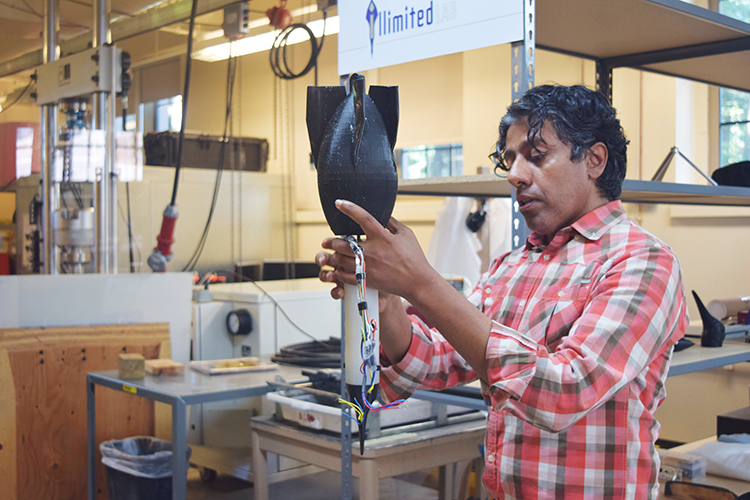Amy Sprague
August 20, 2025

Professor Ed Habtour with one of the Illimited Lab’s avian-inspired divers.
Assistant Professor Ed Habtour has received a prestigious National Science Foundation Faculty Early Career Development Program (CAREER) Award for developing transformative engineering theories that harness the specialized geometric patterns found in biological systems. The award also recognizes the innovative integration of research with education. His awarded research focuses on creating fast biomimetic systems that match the energy and material efficiency of nature's designs. He accompanies this research with innovative teaching methods that promote the integration of biology and engineering and address societal challenges.
The five-year CAREER Award will support Habtour's work in A&A's Illimited Lab, which he founded to reveal the physics of form, function, and motion found in nature. His research promises to simplify the current actuation and control approaches for robots, which often are power-hungry, by engineering functionalized geometries in the structural components of aerial and underwater robots to perform passive actuation and control.
Learning from nature's patterns
"Current bio-inspired engineering primarily emphasizes optimizing regular geometric patterns that are ordered, periodic, and repeated, overlooking the intrinsic geometric irregularities found in nature," Habtour explains. "This approach misses the opportunities presented by distinctive irregular patterns that give biological systems their remarkable capabilities."
His research will develop engineering models for identifying and applying these distinctive irregular patterns to design structures that can match the range of functions and efficiency found in biological systems.
Revolutionary applications
Habtour's research focuses on emulating both the self-actuation and self-control observed in stingrays' swim patterns and the impact-absorbing capabilities of diving seabirds. The research aims to demonstrate two breakthrough capabilities: self-propulsive locomotion without actuators using stingray-like wing structures and impact energy attenuation using seabird neck-like structures without damping materials.
The potential applications span multiple industries. Energy harvesting systems could capture power from ocean waves more efficiently. Smart materials could provide shock absorption and vibration damping without traditional mechanisms. Acoustic systems could achieve better sound control through the use of nature-inspired patterns.
Transforming structural design
Habtour's research represents a fundamental shift in the design principles of current multifunctional structure and modeling approaches in biodynamics. Nature-inspired pattern designs could overcome current limitations that require complex systems for basic functions like movement and energy conversion.
"Unlocking the nature design approach will allow us to engineer actuators and controllers with extremely low power consumption and complexity," Habtour notes. The work promises to extend beyond classical mechanics to develop thin, segmented, curved, and lightweight multifunctional structures without compromising reliability, stability, or control.
By focusing on the geometric patterns that enable biological systems to achieve maximum function with minimum energy, Habtour's research opens pathways to more sustainable technologies. His work exemplifies the University of Washington's commitment to research that addresses real-world challenges while advancing fundamental scientific understanding.
CAREER Awards are among the most competitive honors for early-career faculty, making it especially remarkable that A&A has two recipients in 2025, with Habtour joined by Assistant Professor Karen Leung.
Read more on biomimetic research from the Illimited Lab
Seabird-inspired aerospace adaptations can raise resilience upon impact.
Swimming style predicts skeleton: AI solves stingray puzzle. This research has implications for developing new structures and materials.
Sunflowers architecting sound: Novel approach to reduce noise pollution
NSF funds research on nature-inspired materials for superior noise control and acoustic wave absorption.
Stingrays could inspire new underwater vehicles
A&A researchers look to stingrays for how to develop efficient, quiet and sustainable underwater vehicles.
Spiders can inform how we engineer sensing structures without sensors.